



1st impressions: 10/10
This movie is fantastic. The story writing is done so well and the “real life” and “fantasy” storylines gel together really well. A lot of other films would have struggled balancing these two stories, leaving the audience too invested in one story to find the switch annoying, but Del Toro uses pacing so well that both stories are engaging and neither feels like they are intruding. The practical work is also astounding, as Del Toro’s practical effects usually are. The Faun and Pale Man costumes are so stylish, and the set design is always incredible.
MEMORABLE SEQUENCE: VIDAL EXECUTES THE HUNTERS

Of all the monsters in Pan’s Labyrinth, Del Toro takes great care in making the audience fear Captain Vidal, and this scene is was cements him as a villain. Vidal is brought two men, a father and a son, who claim to be hunters but the soldiers suspect they are rebels. The men are introduced in a mid shot that shows they are surrounded and outnumbered by soldiers. They are also visibly dirty and cowering, showing they are much lower status than the soldiers around them. The camera tracks closer as Vidal begins to inspect their bag and they are manhandled by the soldiers around them. They fidget nervously as Vidal inspects the bag and give explanations for what he finds, obviously terrified of him. Their fearful explanations clearly annoy Vidal, and because of this he draws a glass bottle from the bag, moves in closer to the son as the camera also tracks towards him, before bashing his face in with the base of the bottle, the camera cutting to a low angle shot periodically, showing the son’s point of view. This murder is brutal, and was achieved with a combination of practical effects with digital effects to get the blood spurts right. After the son is dead, Vidal turns and calmly shoots the father twice. he then goes back to the bag and finds two rabbits, proving they were just hunters after all. He chastises the soldiers for not searching them properly and wasting his time, even though he himself was looking through the bag and was obviously aware he hadn’t finished when he killed the two. This scene sets Vidal up as irredeemable and a horrible person, showing the audience that he will be the antagonist for this movie.
10 things that the viewer knows in the 1st 10 mins. 1 – The movie is violent and dark; the first image is a girl bleeding from her nose in reverse and breathing heavily. 2 – the movie contains themes of fairy tales + the underworld. 3 – The movie will have astoundingly beautiful architecture. 4 – The movie will have elements balancing real life and fantasy 5 – The main character is probably going to be the “Princess”, as she is shown first bleeding from her nose before reading the story in a book. 6 – The movie is set in Spain. 7 – They are moving from the town to the country 8 – The mother is pregnant (or some kind of sick).9 – the mother is married to a Captain. 10 – Vidal is set up as a villain
Cinematic breakdown of the 1st 3 mins. – The camera pans sideways along a cobblestone wall, until Ofelia comes into frame, breathing and bloodied. The camera turns to make Ofelia horizontal as it gets closer to her face, before zooming into her eye as we are given the fairy tale. The camera crabs along the underworld skyline, then tracks into the big building with the stairs as the Princess runs into it. It then pans up the spiral staircase to show the sunlight. We then fade into a ruined building. We crab to the right and are shown skulls and more debris, then the camera moves upwards to show more ruined houses before dissolving into the car.
Micro-elements:
Sound – The sound design in Pan’s Labyrinth mostly works to emphasize the brutality of the actions characters take. For example, sound design is used to make Vidal’s murder of the wrongly accused hunters much more brutal, adding crunching and splattering noises to the action, as well as the clinking noise from the bottle to add realism. Sound design is also used to make the Pale Man much scarier, adding deep, haggard breathing to the Pale Man and making the sound of the fairy being eaten crunch and squelch to make the action more visceral.
Cinematography – The cinematography during the Giant Toad sequence works to put the audience in Ofelia’s shoes. The audience is given a lot of close ups as Ofelia crawls through the tunnel, creating a claustrophobic atmosphere. This sequence contains a very inventive mid-shot showing the toad and Ofelia facing each other, with the ceiling and floor of the tunnel closing in on the shot, giving the shot a border, which creates a claustrophobic atmosphere.
Mise-en-scene – The mise-en-scene in Pan’s Labyrinth often serves to tell the audience whether they are in the fantasy world or the real world, as well as telling the audience information about the characters. For example, during the sequence where Vidal has dinner with some of the Spanish elite, the dining room is spotless and well furnished, a fire is burning in the fireplace and the table is lavishly covered in food. This tells the audience that Vidal is on par with these dinner guests in terms of status and spares no expense trying to impress his wealthy guests while he talks with them about cutting rations. Mise-en-scene can also be used to create parallels in the real and fantasy worlds, for example the lavishly set table headed by a terrifying figure is mimicked during the Pale Man sequence.
Editing – the movie uses a lot of stylish transitions between scenes, particularly incorporating wipes into the camera movements themselves, such as the transition during Ofelia’s story from the real world to the story itself, where the camera pans down from Ofelia and her mother on the bed and transition to visuals representing the story.
Representation (Gender)
How are men and women represented differently and how does this position the viewer?
Ofelia – The primary characters in Pan’s Labyrinth are female, the main character being Ofelia, a 10-year-old girl obsessed with fairy tales. Ofelia shows strength and defiance, speaking negatively about Vidal to Mercedes and bravely puts herself at risk in order to fulfil the Faun’s wishes and to protect her mother. Despite her strength, she also does not want to upset her mother, as shown when she tries to avoid her green dress getting dirty when she goes under the toad tree. Ofelia is shown to be selfless and brave, but also vulnerable, as she depends on Mercedes and her mother a lot and is shown to be frightened of Vidal.
Carmen – Ofelia’s mother does not do much in the film as she is heavily pregnant. From the scenes we get with her, it is suggested that she does really care for Ofelia – she embraces her and tells her to talk to her brother in the womb. However, Carmen is shown to disregard Ofelia’s wants in terms of Vidal, whom she prioritizes, as she scolds Ofelia for getting her dress dirty despite her best attempts to keep it clean and takes Vidal’s side when he is verbally and physically attacking her.
Captain Vidal – Vidal is the main antagonist of the film. He serves as a complete binary opposite to Ofelia, as while Ofelia performs her actions with the best intentions, and uses her cunning to thwart her adversaries, Vidal deals with issues with extreme violence.
Mercedes – Mercedes serves as sort of a secondary protagonist in the “Real World” story, working as a double agent for the rebel forces, collecting intel and fighting against Vidal. When she is captured by Vidal, she berates and taunts him by telling him the reason that she was able to get away with it for so long was because of Vidal’s own prejudice, as because she was a woman Vidal didn’t expect she could do anything of her own agency or do damage to him or his image. It is also Mercedes who takes Vidal down in the end too, by shooting him in the face. Mercedes is shown to be stronger and far more capable than Vidal despite being seen as lower than him in society.
Aesthetics
Del Toro insists on original creature designs that have not been seen in o0ther movies. His creature effects are done through a combination of practical and CG effects, for example the faun being mostly a costume with animatronic ears and tail, but the legs were achieved by creating stilts for the actor and using greenscreen to key his legs out. Del Toro has been fascinated with fairy tales and monsters for a long time and uses them in his movies frequently. His team also uses ingenuity in the CG aspects, such as using pictures of crushed leaves to texture the fairies. The film uses a Magic Realism aesthetic, combining a realistic story with a fairy tale inspired world.
Set Design
Del Toro puts a lot of work into his sets so they capture the feeling of fantasy and fairy tales as well as differentiating the magic world from the real world. For example, the Pale Man’s lair creates an area of fantasy, using a lot of pillars, warm colours, and lavish decorations to create an environment separate from the real world. On the other hand, the Real World sets also have a lot of care put into them, such as Vidal’s office. Vidal has converted an old mill into this military base, and in the background of his office a giant wooden cog left over from the mill is clearly visible. This plays into Vidal’s character trait of being obsessed with time, as he is always seen with a pocket watch and often criticizes people for being even a few seconds late.
History and Social Contexts
1939 – Franco takes power over Spain
The film takes place after the military coup of Spain, within an army encampment run by Vidal where they are trying to crush rebel forces. The film takes care to be historically accurate, through costume and mise-en-scene and such. The film also goes out of its way to portray social life accurately for the time, with a standout scene where the fascists have a feast while talking casually of cutting rations. It does differ slightly from real life as at the end the rebel forces defeat Vidal, murdering him outside the labyrinth.
Other context
Despite Del Toro being Mexican, the film is regarded as a Spanish film, because it was made in Spain and used a Spanish crew. According to some sources, Del Toro and his friends put their own money into making this film. It was a passion project for Del Toro.
Budget: $19 Million
Box Office: $83 Million
The film was nominated for many awards, and won best art direction, best makeup and best cinematography at the 79th Academy Awards.
Part 1: Brief Reference
| What did you like about the film? The concept was good, there was some very cinematic and beautiful stills | What didn’t you like? There is a plot hole – how did his murderer travel back in time if they needed the main character to travel in time? Still images were jarring |
| What ideas could you use? Narrative or style? The use of dissolves was creative, improvising with props was nice. I liked the time travel element. | What ideas won’t you use? Why? Really predictable ending, I definitely won’t use still images. I think they could have gotten more out of the time travel |
Part 2: In-Depth Study – Narrative
| Narrative Feature | Example | Your own example |
| Establishing protagonist – what information do we find out? How is it conveyed? | Introduced only in narration – first in third person as “a man marked by an image”; then in first person -memory of incident at the airport. We don’t see him until the first experiment is shown. This shows how core the act of remembering is to his identity – indeed we find out very little about him (he remains nameless) apart from his ‘remembering’ (even when he is travelling in time). | Only talked about in 3rd person. No name given. First seen a full six minutes into the film. No name conveys a more “guinea pig” character. We are shown no backstory apart from this memory, and the only hint to a past for this character is when he is asked about his “combat necklace” from time as a soldier, as well as being referred to as a “prisoner” (though the German whispers of the scientists suggests Frace lost the war and was taken over by another country) Despite not appearing till later, the film opens with the man’s childhood memory at the airport, which is the focus of the action that takes place later. |
| Establishing other characters – what information do we find out? How is it conveyed? | The Woman is the first person we see (“the only image to survive the war”) – and she is defined only by the fact the narrator remembers her. Feminist critics may comment on the fact she barely seems to exist outside the experiences of the narrator and her growing belief in him. | The woman is the first character shown, as part of The Man’s memory. Then we are shown the scientists and other guinea pigs, creating the setting for the films “present”, all before seeing the main character. The “future” humans are distinguished with a dot on their forehead. |
| Establishing location (time and place) – what information do we find out? How is it conveyed? | We are told immediately that the location is Paris. The bombed out wreckage of the city (real WW2 images) don’t immediately establish that this is the future until the narrator mentions radiation. The underground location beneath the Palais de Chaillot is shown by intercut images of broken cherubs and other sculptures. | The setting is told to the audience to be Paris in the third line of the film, and the inventive scene showing the bombing of Paris through whiting out portions of the skyline tells the audience of the post-apocalyptic setting. The tunnels underneath Paris form the majority of the “present” setting. |
| Creating Enigmas – what are they? How are they created? | The image the narrator obsesses over is the central enigma: who is the man he witnesses dying? How does he die? Who is the woman? The still images and voiceover powerfully evoke the nature of memory. | The main enigma presented by the film is the memory of the main character that allows him to travel through time, which is slowly answered by introducing the character if The Woman as a central character and the ending revealing that the whole plot was leading up to creating the memory The Man saw which allows him to time travel |
| Narrative binary oppositions | The ‘Living Present’ vs Past/Future. As the film progresses, what constitutes the ‘present’ (for the protagonist) seems to shift from his dystopian subterranean society to the ‘past’ of pre-apocalypse Paris. This is conveyed by the faster rhythm of the montage and the sequence (18:00-18:49) where the images almost become like traditional cinema. | The predatory and cruel “present” contrasts with the kind past and future. While the “present” is confined in small tunnels and are always claustrophobic scenes filled with darkness, with shadows or sunglasses obscuring the scientists faces, the past is bright and sun lit and open and the future is wide and the people show their faces clearly, and in both times The Man is treated with kindness |
| Crisis – how was this conveyed? | Is it the first experiment? The moment the man spots the woman from the airport? Or is it when the future society offers him the chance to escape to the future? | The crisis point is when the man is to be executed, which is when he makes the choice to use the Future People’s offer to go back in time to the airport to see The Woman again, which leads to one of the Scientists shooting him at the airport, which his child-self witnesses, allowing the plot to happen |
| Resolution – is it closed or open narrative? | The narrative is closed – but it is also in a loop: the narrator is both the dying man and the child watching the scene. This ‘time paradox’ has inspired films as diverse as The Terminator and Looper (as well as 12 Monkeys which is almost a remake). | The narrative is closed in a way that means The Man will relive the plot over and over again, repeatedly witnessing his death and going back in time to be there to be killed. |
Part 3: Meaning and Effect
| What did you think was the intention of the filmmaker(s)? Intellectual message? Emotional response? The film gives the idea of being trapped in one’s past: always preferring life in the past to the present. It also gives the idea of being afraid of the future or what might come, choosing to live in nostalgia rather than giving in and going on to your own future. It says that no matter what opportunities life presents them with, people will choose to trap themselves in the past. | How was this achieved? Your own idea: The collection of stills creates an idea of a fading memory, only recounting a story in still images. The photographs also create an idea of being frozen in time, trapped in moments rather than “moving” along. The only moving image in the film being from the woman, who is symbolic of the main character’s link to the past, also shows this idea of remembering the past more fondly than anticipating the future. |
| Aesthetic binary oppositions The naturalistic representation of the past greatly contrasts with the more interpretive, symbolic representation of the future society | Effect of these oppositions? Your example: This contrast contributes to the main character’s preferable view of the past. |
Inspirations – what ideas did this film give you for your own short film?
| Establishing characters, setting, plot, theme The film manages to do a lot on a low budget, which is admirable | Creating enigmas I liked opening the movie with a mystery to have it resolved at the end |
| Narrative structure (non-/linear? Open/ closed ending?) Opening the movie with the ending with a lot of information absent and then filling in the information at the end was a cool concept | Striking use of technical features The transitions between images were artistic |
Director: Arthur Penn, Writers: David Newman, Robert Benton, Robert Towne
Warren Beatty – Clyde Barrow

Beatty was born in 1937 and had a career spanning six decades. He started his career appearing in TV shows in the 50s, before making his film debut in 1961’s Splendour In The Grass, and received overwhelming praise for his role, being nominated for a golden globe and received an award for best new actor of the year. He later appeared in films like Lilith (1964), alongside fellow Bonnie And Clyde star Gene Hackman, and Mickey 1 (1965). Bonnie And Clyde was the first film he produced, and originally wasn’t going to star in it, but when the other actors who were offered the role turned it down he decided to play the role himself.
Faye Dunaway – Bonnie Parker

Dunaway made her acting debut on Broadway, appearing in performances of Arthur Miller plays like The Crucible and After The Fall, as well as other performances. She performed in the award winning play Hogan’s Goat, directed by a man called William Alfred who became her mentor. Her first film role was crime comedy film The Happening (1967), as well as drama Hurry Sundown, also released in 1967. She was in a six-movie contract with the Hurry Sundown director Otto Preminger, but paid to end the contract after falling out with Otto during production. She was called in by Penn to read for Bonnie Parker after he saw her performance in The Happening, though she had auditioned for a role in one of his films but was turned away by a casting director a year prior. Beatty’s sister was originally going to play the role of Bonnie when he was just the producer, but the role had to be changed when he decided to play Clyde. Dunaway was up against a lot of competition, but Penn was able to convicne Beatty that she was right for the part. Bonnie And Clyde was only Dunaway’s 3rd movie.
Michael J. Pollard – C. W Moss

Pollard was born in 1939 and was an American character actor. He often played quirky, off-beat characters and had distinctive look, making him a “Cult Favourite” actor. He made his screen debuts in episodes of Alfred Hitchcock Presents, before making his film debut as an uncredited role in It Happened To Jane (1959). He went on to appear in films such as Hemmingway’s Adventures Of A Young Man (1962), Summer Magic (1963) and Gunsmoke (1964). He also appeared in an episode of Star Trek. In Bonnie And Clyde he plays C.W Moss, an original character for the film filling the roles of the two real life Barrow Gang members Henry Methvin and D.W Jones. Pollard fulfils his standard character role of a quirky, comedic character. He received a Golden Globe nomination for best supporting actor for this role, and won a BAFTA for “Most Promising Newcomer”. This role also led to his joke presidential candidacy in 1968, complete with a campaign song. He went on to appear in a variety of different films, like Scrooged (1988), as well as roles in low budget horror films like Sleepaway Camp III: Teenage Wasteland (1989), American Gothic (1988), and Rob Zombie’s House Of 1000 Corpses (2003). He died in 2019 of cardiac arrest.
Gene Hackman – Buck Barrow

Hackman was a highly respected actor, considered one of the best of his generation. At 16 he lied about his age to join the army, first stationed in China then moved to Hawaii. He spent 4 and a half years in the army. He was discharged in 1951 and moved to New York. He persued a career in acting but was voted the least likely to succeed (along with friend Dustin Hoffman) by his peers in the Pasadena Playhouse. He performed small roles in television series and performed in off-Broadway shows. His first role was an uncredited role as a police officer in Mad Dog Coll (1961). Another early film role was Lilith (1964), which starred future Bonnie And Clyde co-star Warren Beatty. It was also his first credited role. He had a few small roles in TV and movies until Bonnie And Clyde in 1967, where he played a leading role as Clyde’s brother Buck Barrow, and didn’t become widely noticed until 1970 in his oscar nominated breakthrough role as Gene Garrison in I Never Sang For My Father. From there he gained more respect and became a successful actor, appearing in The French Revolution (1971) and Lex Luthor in Superman: The Movie (1978).
Estelle Parsons – Blanche Barrow

Parsons originally studied law before she became an actress, settling on acting in the 1950s. She was first a writer and producer on The Today Show, and performed in a lot of both on and off Broadway productions, earing awards for performances in Next Time I’ll Sing To You and In The Summer House, and made her film debut in 1963 with Ladybug Ladybug as JoAnne’s mother. In Bonnie And Clyde (1967), she portrays Blanche Barrow, Buck’s danger averse and often hysterical wife. It was only Parsons’ second film role, but she was awarded an Oscar for Best Supporting Actress, an impressive feat. She appeared in a few other film roles, but she was mainly a stage actor.
Denver Pyle – Frank Hamer

Pyle was an actor better known for his television roles than his film roles, appearing in series such as The Range Rider, Have Gun Will Travel, Frontier, Fury and Gunsmoke. The majority of his roles were in westerns, with Pyle usually playing a criminal or cowboy, though he also appeared in shows like The Adventures Of Superman and even an episode of The Twilight Zone. His first credited film role was Devil Ship (1947), and appeared in many more westerns like Red Canyon (1949), Hellfire (1949), Rebel City (1953), and The Man Who Shot Liberty Valence (1962). His frequent (and violent) roles in westerns is probably a large factor in his casting as vengeful cowboy-styled deputy Frank Hamer in Bonnie And Clyde.
Locations

Taking inspiration from the French New Wave, Bonnie And Clyde utilises on location filming in favour of the standard studio filming. For example, the scene where the gang torments Hamer was shot at Lemmon Lake, Dallas, Texas. The majority of the filming took place in Texas, as that is where the real life Bonnie and Clyde operated, adding to the effect of the on location filming.
Sets (Interior)
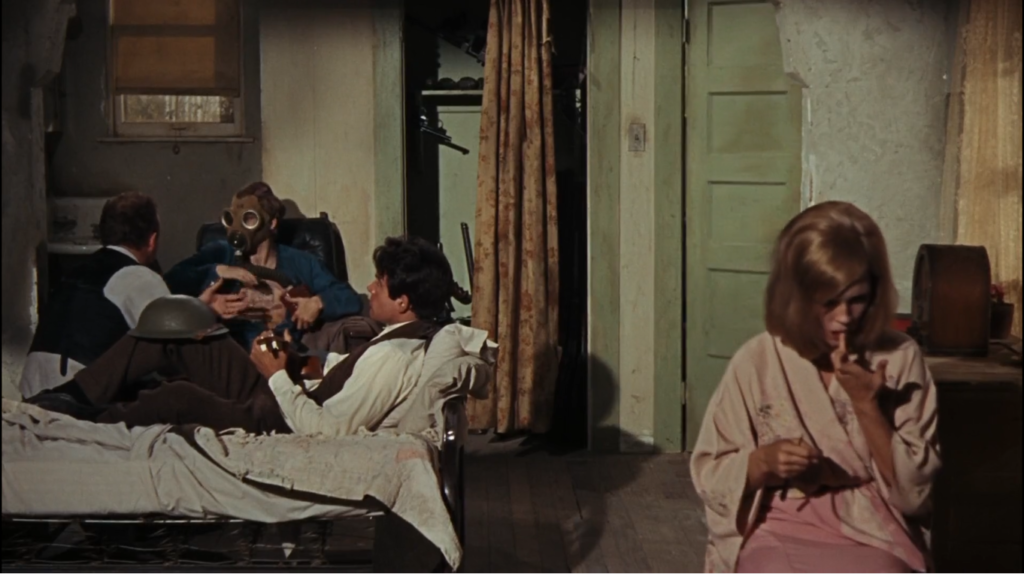
The interior sets are naturalistic but still designed. For example, this scene showing the Barrow Gang hiding out at the Tourist Court Motel, depicting a real thing that happened and a real place (though the real one was in Missouri and the sign in the film says Iowa), adding to the realism of the film. The room the gang stays in is clean and devoid of bags or personal belongings, the only things seeming to belong to the gang being the guns in the closet, the helmet and the gas mask, showing they don’t have many personal belongings and haven’t been in the room for long.
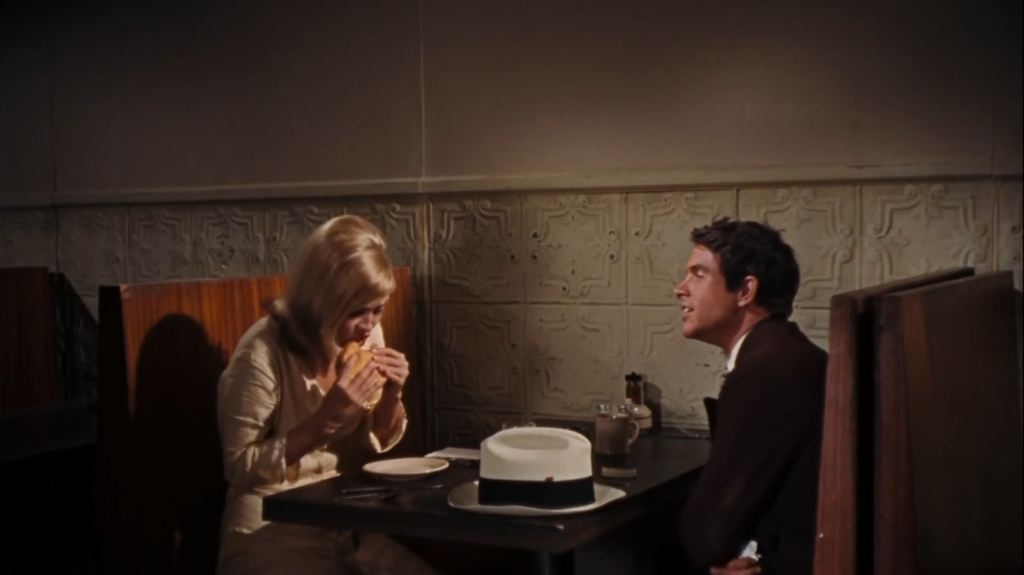
The café scene was shot on location, in Lavon State Bank in Texas. The location was probably used due to how stylish the place looked, the decorated wall and the wooden benches working with the style of the film.
Costume
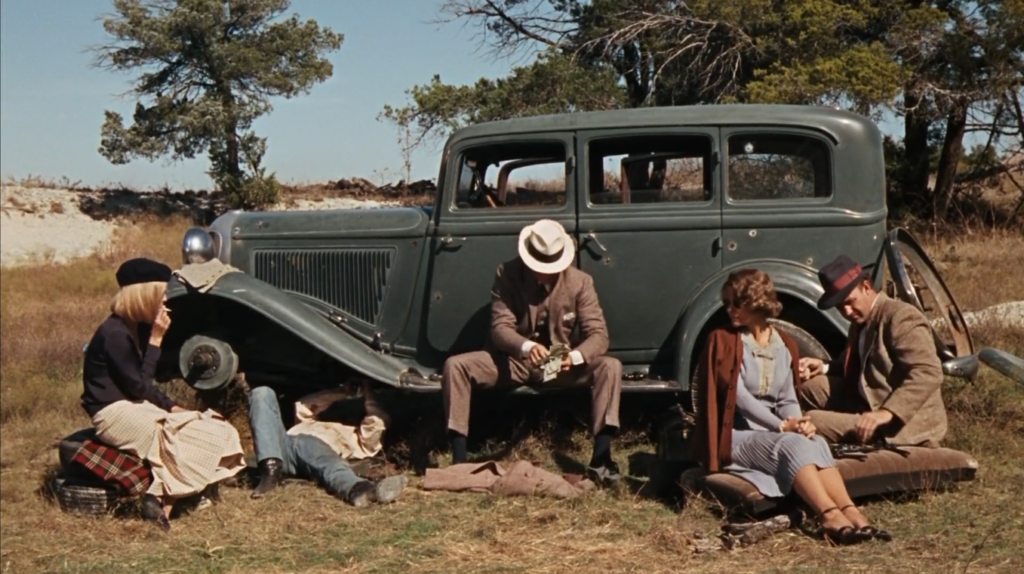
The Gangsters in Bonnie And Clyde dress in glamourous and stylish costumes. The Barrow brothers dress elegantly in suits, waistcoats and hats, possibly inspired by the fedora wearing suit-clad gangsters of the noir films Bonnie And Clyde takes inspiration from. Bonnie is the most notable in terms of costume, becoming a style icon of the time, influencing fashion of the late 60s, evoking elegance and 30’s influence. The costume serves to convey the sense of attraction and sexuality the film wanted to show, and what drew the people of the 30s to the pair of gangsters in the first place.

The antagonist of the film, Frank Hamer, contrasts the costume of the gangsters. While the Barrow Gang wears sleek, stylish outfits and care about looks, Hamer differs, wearing loose clothing and giving a more boxy silhouette than the slim clothes worm by the Gang. Hamer isn’t focused on attention or style, just the job and reputation. The larger stetson also contrasts the hats worn by the gangsters, like the Barrow’s fedoras and Bonnie’s beret.
The editing exemplifies the French New Wave influence and differs from the Warner Brothers “invisible editing” style greatly.


During this car chase scene, jump cuts are used in the middle of the action to show the differing views on the Barrow Gang. We are shown the car chase, scored with the up beat bluegrass chase music, which is fast paced and chaotic. But in the middle of the action, we jump forward in time to an interview with the police chief calling the Gang a menace and swearing to bring them to justice, before getting his picture taken for the paper. During this the bluegrass music abruptly cuts out. After he gets the picture taken the music comes back and we are taken back to the car chase. The chase is interrupted again with another jump cut forward to an interview with a civilian witness. The music suddenly cuts again as the witness says that the gang let him keep his money, and talks of them favourably, before we cut back to the car chase with the chaotic bluegrass music. This is an obvious example of how the editing style differs from classic Hollywood, as the sudden jump cuts break the immersion, which the “invisible editing” style wants to avoid.
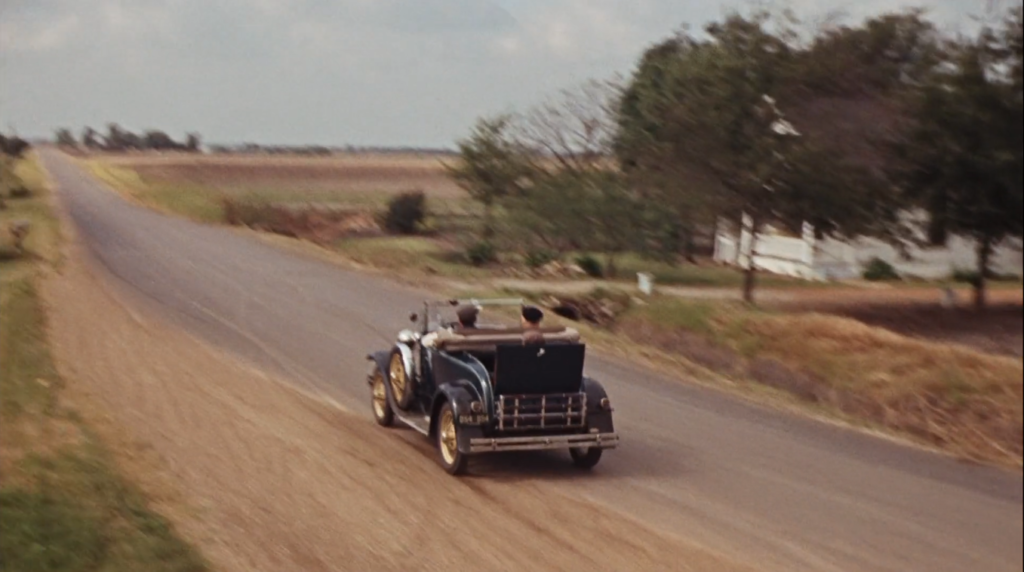
The film has a bluegrass focused soundtrack, specifically using song “Foggy Mountain Breakdown” by Flatt and Scruggs in scenes with action. The bluegrass introduces an excited, light hearted tone to the action, making the crimes committed by the gang seem fun. The bluegrass genre intones the south/Texas and an old time feeling (though bluegrass was more of a 1940s sound than ’30s). The bluegrass is non-diegetic and serves as a motif to the action scenes.
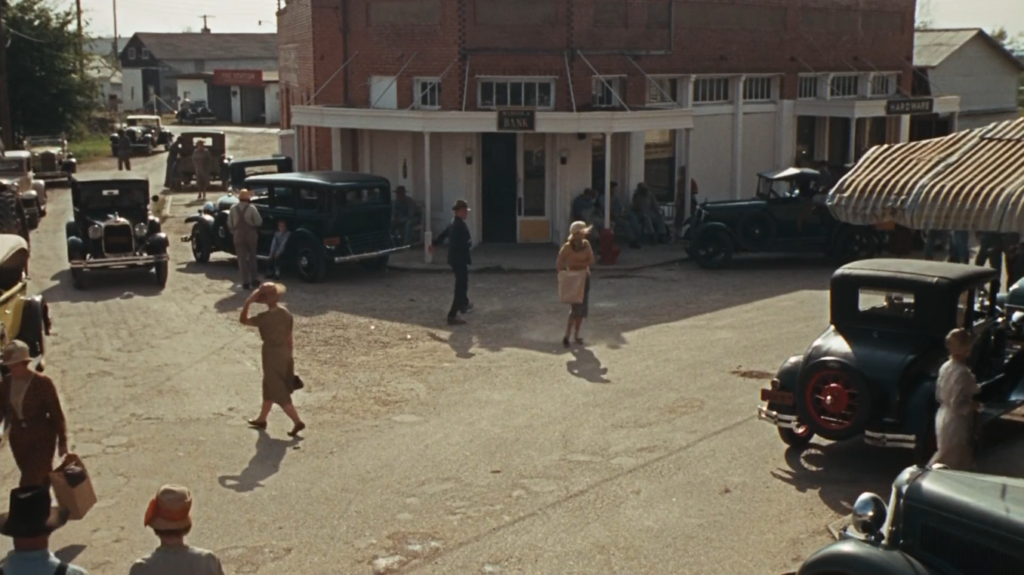
The film uses diegetic sound too, such as the alarm ringing after Bonnie and Clyde rob the bank.
Realism
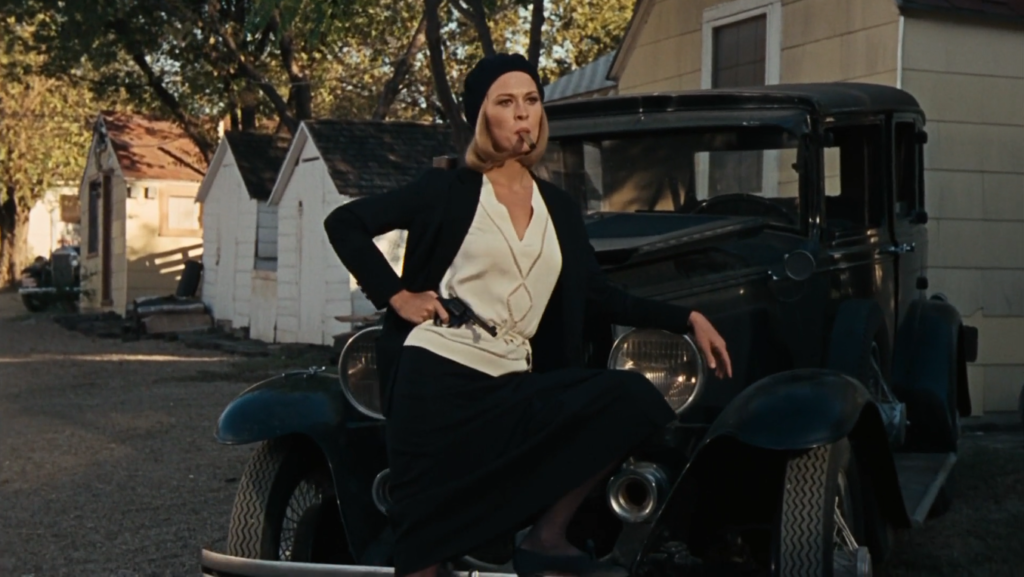
The film focuses on realism and historical accuracy, though it does greatly simplify the real story (C.W Moss being a composite of the real D.W Jones and Henry Methvin). The focus on on-location filming adds to the realism element, filming all around the north of Texas, close to the real places the criminals operated in. The film also depicts many real events, such as the taking of the iconic photo of Bonnie on the car (above), the final shooting of the couple (though the depiction is far less violent than the real life shooting) and the Tourist Court shootout. The film was also one of the first to feature extensive use of squibs to create realistic blood spurts when characters are shot. During the time Bonnie And Clyde was released in, gunshots were bloodless and painless, so the depiction of blood and pain when someone is shot was seen as very graphic for the time.
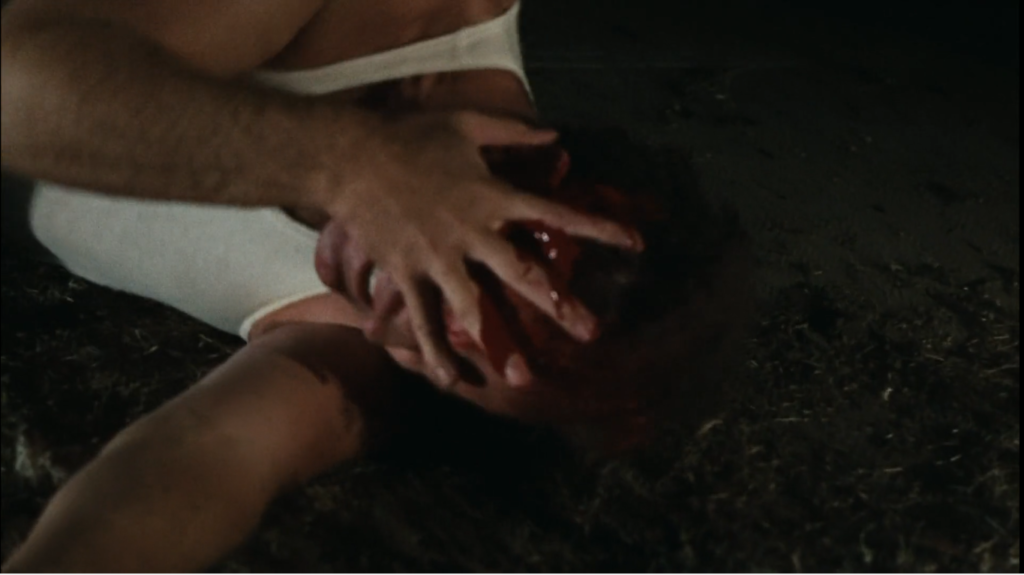
Tone
Bonnie and Clyde has a varying tone, some scenes being light hearted, some comedic, some scenes being romantic and others being very serious. Often the car chase scenes and the robberies being comedic and light hearted, scored with exciting music and showing the gang usually enjoying themselves. Some scenes are quite comedic, like when Clyde tries to get out of the car after telling Bonnie he has erectile dysfunction and banging his head on the doorframe, when he tries to rob the bank that went out of business due to the great depression and when Moss tries to show off his tattoo to his father. Bonnie and Clyde obviously feature in a lot of romantic scenes, where they banter and play off each other and flirt a lot. The film is also able to be serious however, in the shootout scenes and scenes featuring Hamer. The serious scenes often take place at night or not vibrant lighting, and don’t contain scoring, containing gunshots and cries of pain mostly.
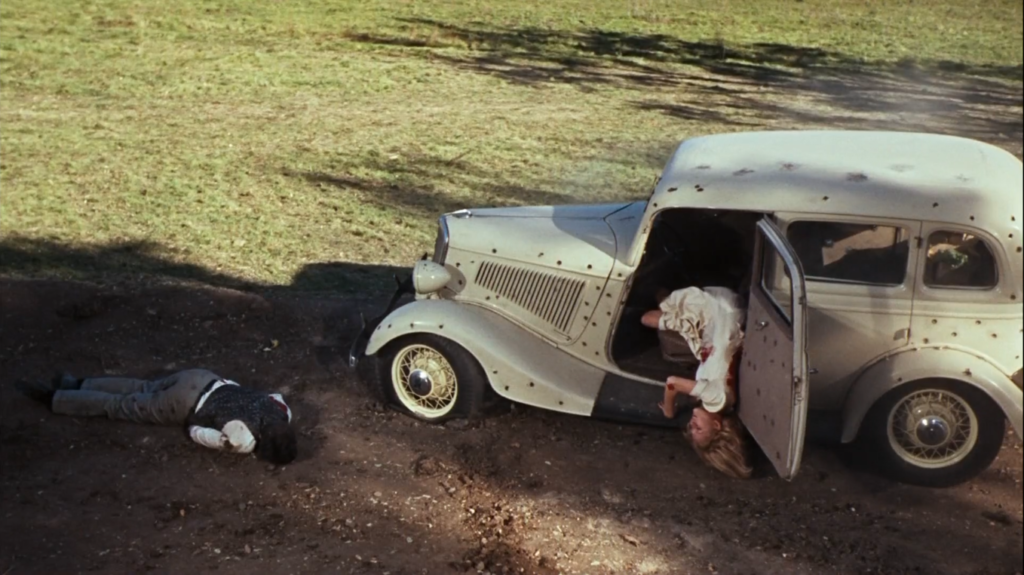
These tones are also able to play off each other to create mood, such as the end of the film, when the audience knows Hamer has tracked them down and will ambush them by the end of the film while the film shows us the couple enjoying themselves in the town. The film is able to balance these tones to make the light hearted, fun scenes don’t seem out of place with the more serious scenes.
Visual Style
The film takes a lot of inspiration from the French New Wave visually, making use of close-ups, jump cuts, camera angles, etc. to give scenes a dynamic feel and make the film engaging.
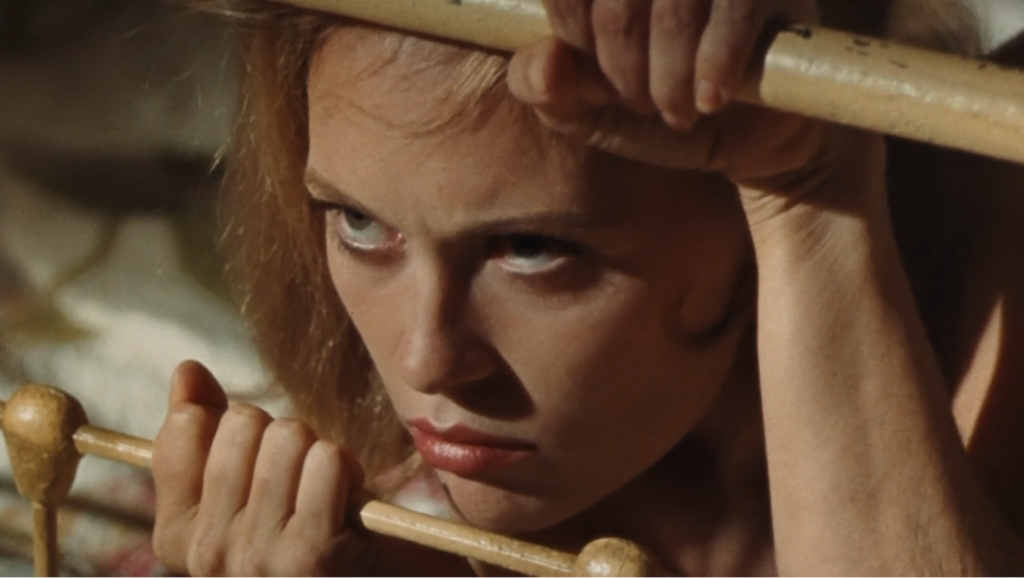
The opening scene with Bonnie in her room is a good example of the film’s visual style, starting with a close up on Bonnie’s lips, then panning to Bonnie in a mirror, then jump cutting to Bonnie standing up and walking to the bed, then jump cutting again to Bonnie lying down on the bed. The editing is erratic and involving, and the filming works to show the audience Bonnie’s character, using her head as a visual metaphor for Bonnie feeling trapped in a mundane life. This varies greatly from the generic wide shot and shot-reverse-shot that was very typical in Hollywood at the time.
Women

Bonnie Parker is atypical of women in film in the 1960’s. Bonnie is presented as an equal to Clyde, and is treated with respect by the film. She smokes, shoots, kills, does crime and wears stylish clothes. She is able to laugh at the male characters, has her own agency and personality, and Clyde supports her in her interests in poetry (sticking up for her when Buck doesn’t take it seriously) and allows her to see her family when she asks him to. The character presents the interest the real Bonnie Parker drew from the American public through her attitude not typical in women in the 30s, smoking cigars and robbing banks, acting freely.

Contrasting this is Blanche, Buck’s wife. She is a more typical representation of women of the time, very hesitant to be involved in the Gang’s actions and very often hysterical. While the majority of Blanche’s character is stereotypical, she is given moments of independence, for example demanding a share of the money from Clyde.
Men
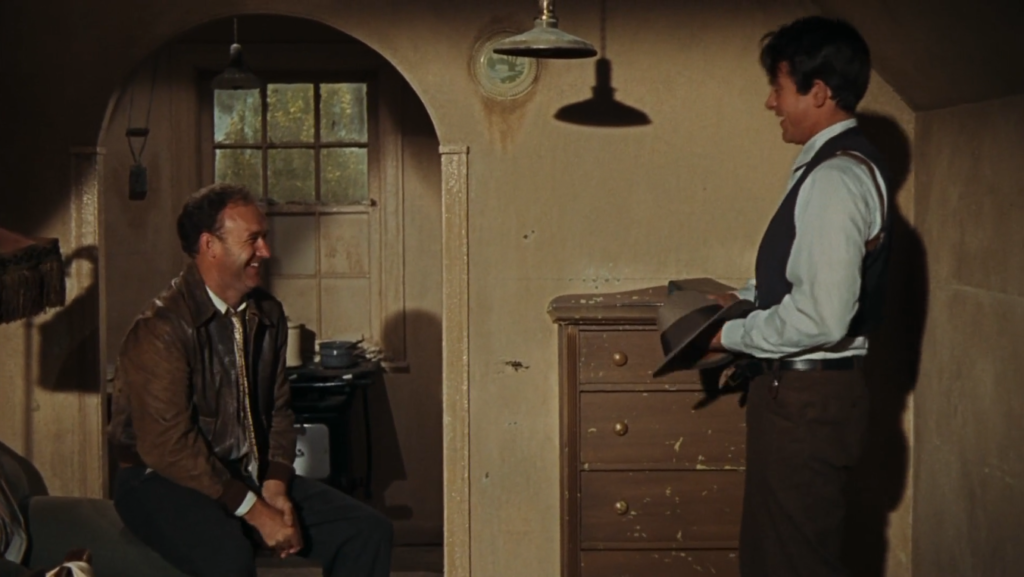
The men of Bonnie and Clyde are men of action, though not entirely typical. Clyde introduces Bonnie to the world of crime, teaches her how to shoot, takes charge in situations and is suave and confident, all quite typical of a male character. However, Clyde is very supportive of Bonnie through the film, defending her poetry to Buck, becomes very aggressive to Hamer when he spits on her and lets her see her family even though it could be dangerous to the gang. Clyde is also used as comedy through his masculinity as well, such as when he bangs his head on the car door when leaving the car, or when Bonnie laughs at him for trying to rob a bank that went out of business, and even his first robbery is a result of trying to show off to Bonnie. His brother Buck is similar, falling into aspects typical of a male character, leading action and being a more obvious comic relief character, telling bad jokes and roughhousing with Clyde when they first meet, but he also sticks up for Blanche, defending her when Bonnie snaps at her and speaking up for her when she asks for a share of the money.
Authority Figures
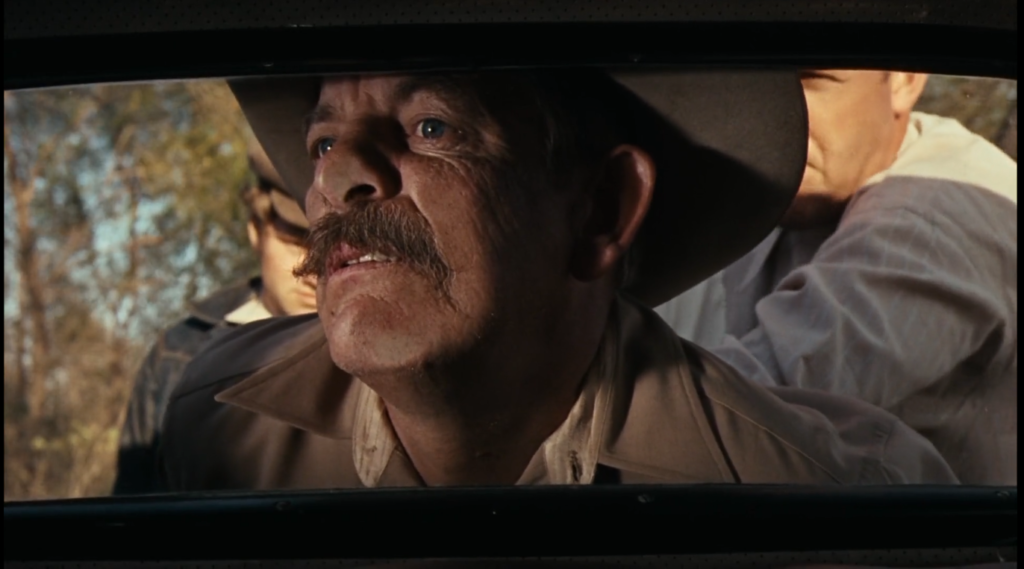
The authority figures in the film are the antagonists, menacing the Barrow Gang, being stuck up and cruel. Frank Hamer, the main antagonist of the film, is presented as a mean, tough man, chasing the Barrow Gang mainly for petty revenge. He mistreats a newly blinded Blanche, getting information out of her and then leaving the room without telling her, leaving her talking to no one. He uses people, spits on Bonnie, is very aggressive and overkills Bonnie and Clyde greatly. The authority figures in Bonnie And Clyde are villainous and aggressive, presented in a very negative light.
People Of Colour

There are barely any people of colour in the film, and the ones that re in the film are not given much screentime. The most notable representation of people of colour is when Clyde gives a farmer his gun to let him shoot his repossessed house, which the farmer then gives to his black farmhand, who also shoots the house. The person is treated with mild respect, but is still depicted in a stereotypical way as a manual labourer and doesn’t have any lines.
Working Class Americans
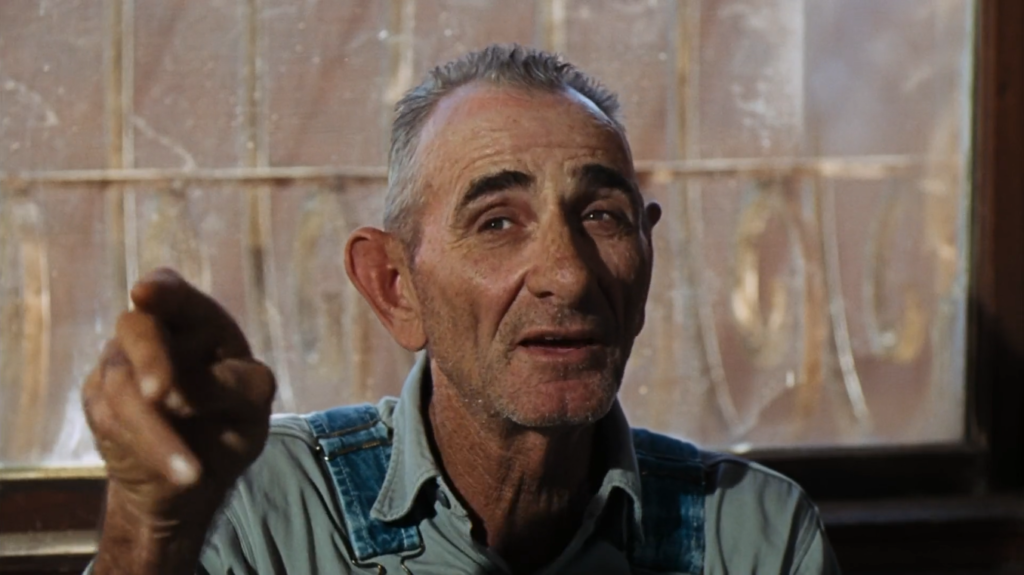
The working class of America are presented as sympathetic. The main characters Bonnie and Clyde are members of the working class, Bonnie being a waitress and Clyde was a petty thief. The gang’s motivations are to rebel against the upper classes, showing disdain for authority and those with wealth and showing sympathy to those in the lower classes. During a robbery, they let a man keep money he was withdrawing from the bank before running away, and the man tells the press that that the Barrow Gang are all right with him. Bonnie and Clyde create solidarity among the lower classes and the less fortunate by rebelling against the status quo.
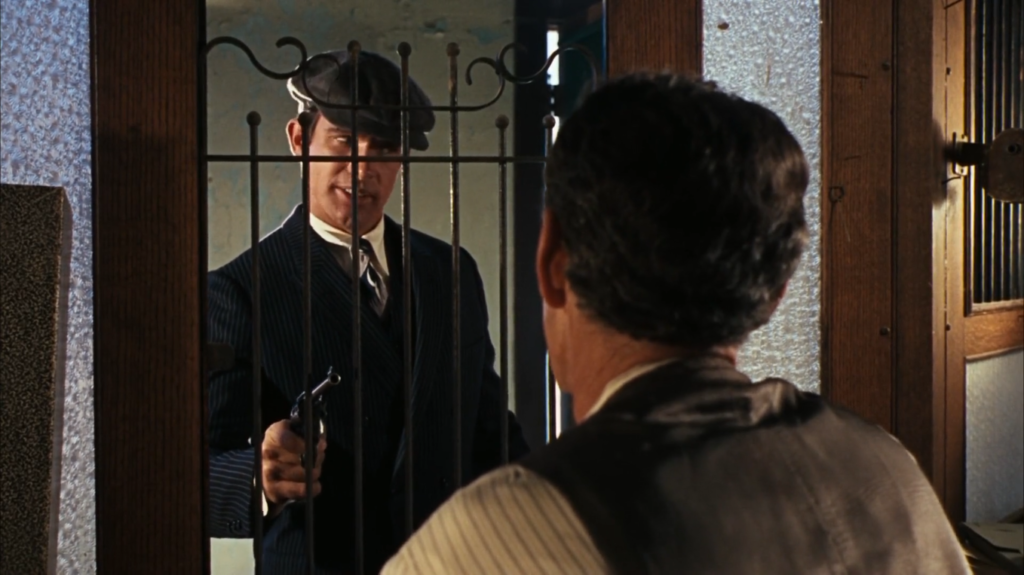
Bonnie and Clyde takes place in the 1930’s, a time of struggle. The Great Depression and the Wall Street Crash serve as the main backdrop behind the actions of the main characters. The Great Depression was an economic crash in the 30’s that caused high levels of unemployment and poverty. People lost a lot of money and it was a time of misfortune and loss. The film shows Bonnie and Clyde robbing banks in retaliation to the poor losing houses and items to repossessions, showing them in a heroic light as they fight against authority and the effects of the Great Depression.

The 1960s – when the movie was filmed – was also a time of social turmoil. Near the start of the decade, president John F Kennedy was assassinated. Before this, he was leading the USA in dealing with the Cuban Missile Crisis, part of the Cold War, which garnered a lot of fear in the American population. JFK was becoming disliked among the American population due to his poor handling of the Vietnam war, which led to a time of social revolution where people began campaigning for peace and freedom. Counterculture became popular in America, as the population disagreed with the current government and didn’t want any more conflict or war. Dislike of authority grew. People campaigned for progression and liberation, wanting equality for women and minorities. These counterculture attitudes also entailed a sexual revolution. This disdain for authority and call for revolution probably influenced the themes of Bonnie And Clyde, such as giving strength to the female characters, rebellion towards authority and liberation.
Rating: 10/10
I was already interested in the real life case of Bonnie And Clyde, so I was excited for this movie and it definitely lived up to my expectations. It wasn’t very historically accurate but it was engaging, and there were a lot of standout scenes. The shootouts were engaging and tense, and the film was also surprisingly funny in a few scenes. I found the character dynamics interesting to watch, and the film itself looked beautiful, portraying American country landscapes and small towns.
Standout Scene: After The Shootout/Buck Got Shot

This film really stood out to me as it was really dark compared to what came before it in the film, and it acts as a turning point in the tone in the movie. This scene comes after a tense and action filled shoot out between the police and the Barrow gang. During this shootout two very important things happen: Buck gets shot in the head, and Blanche gets shot in the eye. This scene after the shootout is the Barrow gang trying to save Buck. The lighting really takes effect in this scene: it takes place in the night, the only light source being from the car headlights. The light casts shadows over the characters, making the shots interesting to look at. The darkness compliments the tragic events the characters experience. This is the first time the Barrow Gang has suffered consequences to their actions, and it is a real tragic moment in the film. There is no underscore, the only sounds are Blanche’s screaming, Clyde and Moss helping Buck, Bonnie uncharacteristically trying to comfort Blanche (A change in character, as Blanche and Bonnie were always against each other), and Buck’s delirious talking as Clyde bandages his head wound. Its a slow, harrowing scene, and marks the movie’s descent into tragedy.
Humphrey Bogart – Rick Blaine

Bogart was on contract with Warner Brothers, and initially they didn’t want the role of Blaine to go to Bogart, having Ronald Reagan in mind instead. But the role was written with Bogart in mind, and the producers fought to have him in the film, and eventually succeeded in having his inclusion. Bogart made his cinematic breakthrough a year before he starred in Casablanca, in a film called High Sierra (1941), and he became even more famous as the lead in The Maltese Falcon (1941). He used to play bad guys or Private Detectives (“Tough Without A Gun”). His role in these noir detective stories probably influenced his casting as the coarse, blunt Rick Blaine, as well as his know roles as a leading man, though this performance made his future roles more heroic.
Ingrid Bergman – Ilsa Lund

Bergman was an actor of Swedish nationality. She was originally featured in Swedish and German films, typically in dramas such as 1935’s Ocean Breakers and 1939’s Only One Night, before being presented to American audiences reprising a lead role in the American remake of Swedish film Intermezzo: A Love Story (1939), the original of which she also starred in. Originally, producers were worried her name was too German, and about the fact that she couldn’t really speak English, yet she was accepted in her first American role with no changes. She was completely devoted to her work on the films she worked on. She was an activist, protesting racial segregation in America and travelling to Alaska and other parts of Europe to entertain troops after the war ended. Before Casablanca, her most well known role, she appeared in MGM films Rage In Heaven (1941) and Dr Jekyll and Mr. Hyde (1941). Her casting in Casablanca was influenced by her foreign background and her well-known beauty.
Paul Henreid – Victor Lazlo

Henried was Austrian-American, and also worked in Hollywood as a director and producer as well as an actor. His first credited American role was in Goodbye, Mr. Chips (1939). His other big hit aside from Casablanca, Now Voyager (1942), was released just a month before Casablanca. He escaped from the Nazi regime to the UK and America after being designated as an official enemy of the third Reich, and had his acting career in these countries being vouched for by The Cabinet Of Dr. Caligiri star and Casablanca‘s villain Conrad Viedt. While he was in Nazi Germany, he was not allowed to act due to his father being born Jewish.
Claude Rains – Captain Louis Renault

Rains was born in London and was most known for acting in a lot of the Warner Bros. Classic Monster movies, such as The Wolf Man (1941) and the lead role as Dr. Jack Griffin in his American debut film The Invisible Man (1933), as well as starring alongside fellow Casablanca star Paul Henried in Now Voyager (1942). He worked from 1931 all the way through to 1965, only two years before his death, and was a very prominent actor for Warner Bros., appearing as important roles in many very popular films.
Conrad Viedt – Major Heinrich Strasser

Viedt was a very popular German actor who most prominently appeared in horror films in antagonistic roles, famously in The Cabinet Of Dr. Caligiri (1920) and The Man Who Laughs (1928), as well as other villainous roles like Ivan The Terrible in Waxworks (1924) and Rasputin in Rasputin: Demon With Women (1932), though very rarely he did play the hero character such as Phileas Fogg in Around The World In 80 Days (1919). When the Nazis began censoring the film industry and Viedt was forced to state his race on a questionnaire presented to everyone in the film industry, he answered “Jew” in solidarity to his Jewish wife, even though he himself wasn’t. He then left Germany with his wife to work in England. In Casablanca, the second last film he featured in before his death in 1943 and the last film he featured in that was released in his lifetime, he sticks to his villainous roles as he plays antagonist Nazi officer Heinrich Strasser. Viedt was most likely cast in this role due to his career playing villains and his German heritage.
Sydney Greenstreet – Signor Ferrari

Greenstreet didn’t start acting on screen until he was 61 in the role of Kasper Gutman in The Maltese Falcon (1941) alongside Humphrey Bogart and Peter Lorre, though he did appear in a few stage productions before this. Casablanca was the fourth film Greenstreet was in, as Rick’s rival bar owner Signor Ferrari, and he continued to have a long career in film until 1949, where then switched to radio drama series The New Adventures of Nero Wolfe in the titular role from 1950-1951, until his retirement from acting, followed by his death from complications with diabetes and Bright’s disease in 1954. I believe Greenstreet was cast in this role due to his elderly, “portly businessman” appearance fitting the role of Ferrari.
Peter Lorre – Ugarte

Lorre was a Hungarian character actor, and well known for playing timid yet devious characters, and appeared in a lot of crime films such as alongside Casablanca co-stars Bogart and Greenstreet in The Maltese Falcon (1941), and others such as Hitchcock’s The Man Who Knew Too Much (1934) and Mad Love (1935), as well as starring as the main character in the 1935 adaptation of Crime And Punishment and as the leading Mr. Moto in the Mr. Moto film franchise (1937-1939). Originally starring in Austrian and German films, he made is debut in American film in 1934. During his American career he was often typecast as a “sinister foreigner”, playing antagonistic roles. His role as Ugarte in Casablanca is a small but important one, as Ugarte is an American in Casablanca who sells letters of transit to refugees. He provides Rick with the Letters Of Transit (which he obtained by murdering two German couriers on a train), and then is subsequently executed. This sketchy black-market dealer character aligns with the characters Lorre usually played.
S.Z Sakall – Carl

Sakall was a Jewish Hungarian character actor. He appeared in various Hungarian stage productions and films from the 1910s to the 1920s and was a star. When Hungary joined the Axis powers in WW2 he emigrated to America and became an actor there. A lot of his family were killed in Nazi concentration camps. His first American role was 1940’s It’s A Date, though his first big hit was 1941’s Ball Of Fire. He was very well known for appearing in light-hearted romance movies, like the German Two Hearts Waltz In Time (1930), Must We get Divorced? (1933), and The Devil And Miss Jones (1941). His career in supporting roles in these romances is possibly what led to his casting as the waiter Carl in Casablanca.
Madeleine Lebeau – Yvonne

Lebeau was a French actress who fled Paris with her Jewish husband Marcel Dalio when the Second World War started and found an acting career in America. Her first film role was in the French film Girls In Distress (1939) in an uncredited role as a student, before she had to flee France. On her passage to America, she was stranded in Mexico when the Chilean visas purchased by her and her husband turned out to be fakes. She learned English during a 7 week stay on a Portuguese ship looking for port. Her Hollywood debut was in 1941’s Hold back The Dawn. Originally having a bigger part in Casablanca as Blaine’s discarded fling Yvonne, each rewrite of the script made her part smaller. Her standout scene is when she is shown during the chorus singing the French national anthem to drown out the Germans, where her face is shown in a close up with tears on her face, and subsequently cries “Vive la france! Vive la liberte!”. This scene probably meant a lot to her, as he could relate to the feeling of French patriotism. She was the last surviving credited cast member of Casablanca as of 2008, until her death in Spain in 2016.
Dooley Wilson – Sam

Wilson was born in Texas as Arthur Wilson, being given the nickname “Dooley” after a popular performance of his where he did whiteface and played an irishman singing a song called “Mr Dooley”. He was a musician as well as an actor, singing the song “As Time Goes By” himself, though he was not a pianist, so the piano music was played offscreen by someone else. He obtained a contract with Paramount Pictures after a breakthrough role as Little Joe in Broadway production Cabin In The Sky. His first film role was in boxing movie Keep Punching (1939). Casablanca was his sixth film role, as bar pianist Sam, who performs music for patrons of Rick’s and has been friends with Rick since Paris. Wilson was probably cast in this role due to his past as a singing performer.
Joy Page – Annina Brandel

Page was born to Mexcan-American silent movie star Don Alvarado and a mother descended from Russian-jewish refugees. Her parents divorced when she was 8 and her mother remarried to the head of Warner Brothers, Jack Warner, when Joy was 12. Warner did not approve of Joy’s interest in acting. When Joy got the script to Casablanca, her first movie role, she thought the film was old fashioned and cliché, but still she obtained the part of married Bulgarian refugee Annina on her own, and her stepfather reluctantly agreed for her to be in the film. She was one of only three American born actors on the film, alongside Bogard and Wilson. Her stepfather banned her from signing her on any contracts with Warner Brothers, so she went on to appear in films from other studios. She married actor William T. Orr in 1945, who later went on to become an executive for Warner Bros. She was the second surviving member of Casablanca alongside Lebeau, until her death in 2008.
John Qualen – Berger

Qualen was a character actor of Norwegian heritage who often used accents, usually Scandinavian accents, in his roles. in his career he appeared in over 100 movies and also featured on television. He gained his start in acting as part of the Chautaqua circuit troupe, before forming his own theatre troupe, The Qualen Concert Company, with his wife. He gained a big break in Broadway in 1929 as a Swedish janitor in the performance Street Scene, a role he recreated in his first film role, which was a film version of the the play. He became a part of director John Ford’s stock crew after being cast in his film Arrowsmith (1931). His role in Ford’s crew lasted all the way through to the 60s. Two years before he was cast in Casablanca, he featured in hit film The Grapes Of Wrath (1940). For his role as Berger, a revolutionary pretending to be a jewellery salesman, in Casablanca, he used a slight Scandinavian accent, that being his most used accent in his acting gimmick.
The setting uses lots of things that gives off interesting looking shadows, like shutters, the fancy table lamps, ceiling fan etc.

The film was constructed on a studio stage and not on location (due to the war going on). This was an opportunity for the set designers to create a fantasy-like world of Casablanca, filling it with exotic trees and strange architecture that created a place where the audience could get lost in.

The characters dressed abnormally well, adding to the fantasy feel of the film, and even refugees from the law were dressed in suits and ties and beautiful dresses. The good guys were dressed in light colours (e.g Rick Blaine’s white suit) and the bad guys in dark colours (e.g Strasser’s Nazi uniform).

Casablanca uses the standard “Invisible editing” style of Hollywood at the time. This style attempted to fully immerse the audience and make cuts seem invisible, presenting the film as one smooth continuous story.

The editing in Casablanca is also good at creating engaging sequences, like the scene where Rick rigs the roulette table so Annina and her husband can buy a visa to escape Casablanca. The scene is low stakes – It’s Rick’s establishment, so he can’t get in trouble for cheating, and even if the husband loses, that couple aren’t main characters. But the quick cuts of Rick to chips to wheel to the husband winning repeated twice creates a quick, engaging scene that goes quickly and keeps the audience invested
The majority of the cast of Casablanca were immigrants. 34 different nationalities were displayed in the film. There were only three Americans on the cast: Bogart, Page and Wilson. The rest were European refugees, from Germany, Hungary, Austria, France etc., all countries affected by Nazi invasions.

The film is not intended to be realistic. It looks like it’s a stage play, and the sets fit the American ideas of what Casablanca, a country exotic and far away to them, would be, even if it is boring in reality. The characters also wear impossibly good, stylish clothing, which again is not questioned by the audience as it fits the world created within the film.
The tone of Casablanca is for the majority of the film quite bleak. The Nazi’s are all over the city, people are being executed everywhere, Rick is a no-nonsense man who seems to constantly be annoyed by everything and Victor is in danger of being captured and killed. However, the film ends on a surprisingly positive note where Rick lets Ilsa go, the Nazi commander is shot and killed, Victor escapes and Rick leaves Casablanca with Louis. It almost feels like a fantasy, fairy-tale ending, which fits with the films storybook aesthetic.
Isolationism – a policy of remaining apart from the affairs or interests of other groups, especially the political affairs of other countries.
What was America’s view on World War 2? – America initially wanted to remain neutral (96% of polled American citizens believed America should stay neutral, and WW2 was referred to as “that phony war in Europe”), although they did supply military supplies as well as other assistance to the allies. They officially joined the war, however, when they themselves were attacked at Pearl Harbour. This is similar to the character of Rick, who initially claims to be neutral in all cases, despite helping resistance fighters before moving to Casablanca, but then sides with the Allies and fights against the Nazis once the war puts Ilsa in danger.

The song “As Time Goes By”, though not written for Casablanca, became synonymous with the film. Written by Herman Hupfeild for a Broadway musical, it was repurposed for the film and practically became the theme song for the film. Max Steiner, the composer, was not a fan of the song, but since they couldn’t reshoot the scene where Ilsa asks Sam to play the song due to Bergman having her hair cut for another role, he had to use it. He implemented the tune of the song into the underscore of the film and it became a leitmotif for romance in the film

Another song featured in the film is the French national anthem “Les Marseillaise”. This scene is one of the emotional high points of the movie, as the entire bar joins in singing the song, drowning out the Germans singing their own national anthem. In this instance, music is used to represent rebellion and defiance in the people, and how there is still hope in the victims of the Nazi regime
The film also has a constant orchestral underscore to the movie, composed by Max Steiner, giving it a more “epic” feel and giving the emotions of the movie more depth, while also adding to the theatrical feel of the movie.
Allies – Great Britain, U.S.A, U.S.S.R
Axis – Germany, Italy, Japan
France – Originally an Allied power, surrendered to Germany. Some generals and soldiers still decide to fight on (called the Free French – Allied). Vichy France was a territory of France that was run by the Germans. Vichy France runs Casablanca (Morocco is part of French territory)
War starts in 1939. America joined the war in 1941 due to Japan bombing Pearl Harbour.
The cinema had “movie reels” before the movies started, at this time of what was happening in the war. This was a primary way that the American population gained information on the war.
Operation Torch – Operation Torch (8-16 November 1942) was the Allied invasion of French North Africa. It allowed America to begin the fight against the Axis powers while Britain could secure victory in North Africa.
Film “captured the zeitgeist” – Casablanca was all over the news and in popular culture due to Operation Torch and the conference. The film premiered November 26 1942 instead of the anticipated release date of early 1943 in order to capitalise off of the attention the name Casablanca was getting. The film was released only 10 days after Operation Torch ended.
Casablanca Conference – The conference was a meeting between American President Franklin D. Roosevelt and British Prime Minister Winston Churchill in Casablanca about strategizing for the next steps in the war on January 14-24, 1943.
Casablanca went into general release on January 23, 1943, just before the end of the Casablanca Conference, allowing the film to continue profiting off of the news.
Serendipity – luck, chance

The Third Man (1949, Carol Reed)
Film Noir is a style of film popular in the 1940s-1950s. Noir films are shot in black and white, and have a focus on shadows in the cinematography. The Noir genre focused on plots around hard boiled private detectives, femme fatales, murders and the mafia/gangs.


Night Of The Hunter (1955, Charles Laughton)
Neo Noir
Neo Noir is a modernised version of the Noir style of the 40s with more graphic depictions of violence. It modernises the pessimism and mean nature of the classic Noir style for contemporary audiences

Taxi Driver (1979, Martin Scorsese)

The Crow (1994, Alex Proyas)
Rating: 9/10
Casablanca is a romantic drama made during the second world war and set in the Nazi controlled Moroccan town of Casablanca, in which bar owner Rick Blaine is involved in the escape of resistance fighter Victor Lazlo, made more difficult by the involvement of his old girlfriend from Paris, Ilsa Lund. This is a generally highly rated film, and I have to agree that Casablanca is a very well made and well acted film with a very interesting story. Its a fantastic film that deserves all the praise it gets.
Memorable Scene: Ilsa leaves Casablanca with Victor

This scene serves as the end to the film as well as its emotional climax, and it is definitely the most memorable part of the film to me. Rick, deciding to help Ilsa by giving her the letters of transit, holds the police captain at gunpoint and drives her and Victor to the airport. Ilsa is under the assumption that she will be staying with Rick while Victor leaves for America, however Rick has arranged for her to leave with Victor without telling her to make sure she leaves. Rick explains that Ilsa has to leave with Victor because she motivates Victor to keep going and because Victor loves her. The reveal of Rick sending Ilsa away to America is accompanied by a swelling underscore which raises the emotional impact, as well as a dramatic zoom in to Rick and Ilsa’s faces. This scene also shows Rick’s character development, as in the beginning he was a sour, mean man who did have moments of kindness that he conctantly undermined. He insisted he was neutral in all matters, and when it came to Ilsa and Victor he was aggressive and resentful towards the two of them due to his past with Ilsa, which is a pathetic side to him as he endangers Victor’s life by not giving him the letters of transit because Ilsa left him. However by this scene he has changed, and stops being mean towards the couple and lets his petty grudge against Ilsa go, allowing her to be free and letting Victor escape the Nazis. The score, close up shots and amazing acting from Bogard and Bergman really makes this emotional scene extremely impactful . Also I cried.
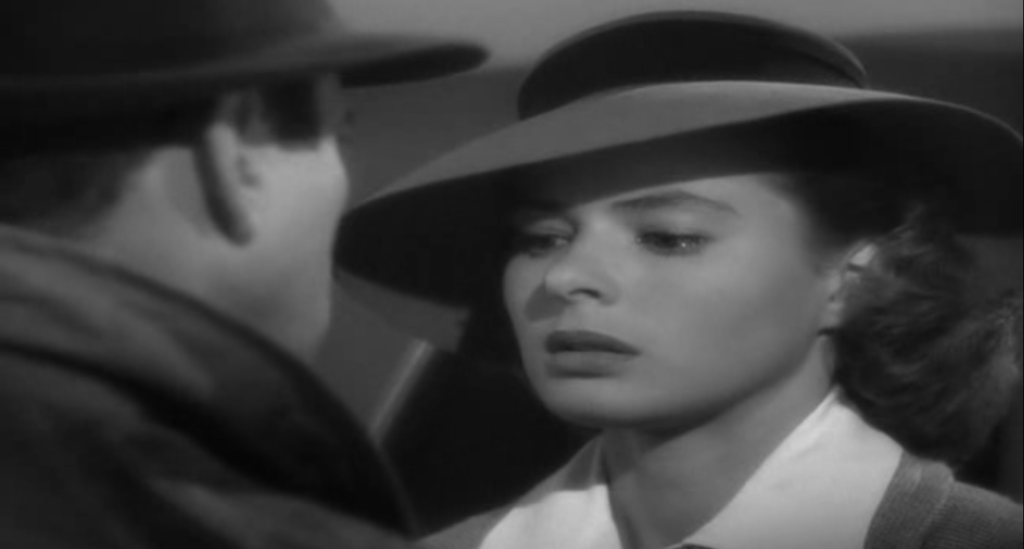
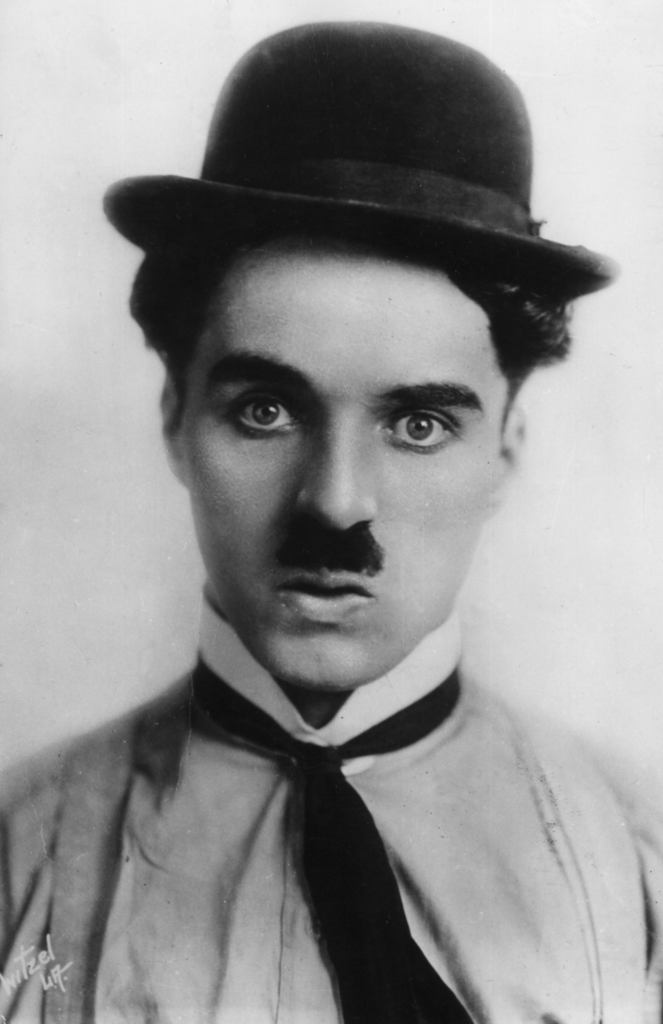
Charlie Chaplin, famous silent director and actor (1889-1977)
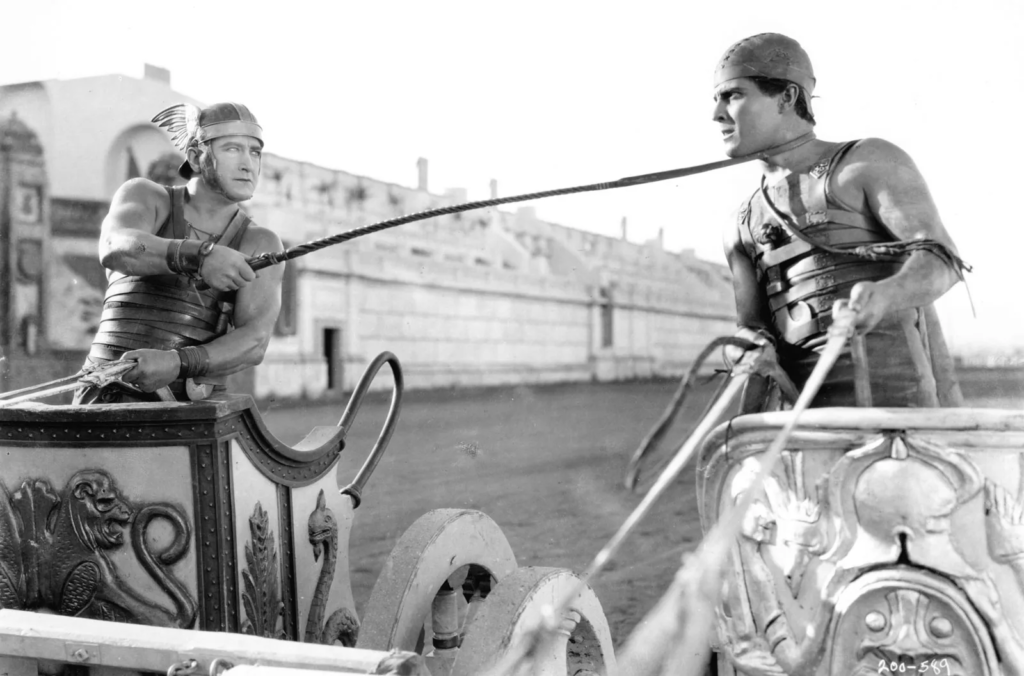
Ben-Hur: A Tale Of The Christ (1925)
The five big studios were:
– MGM, which did high budget films and literary adaptations
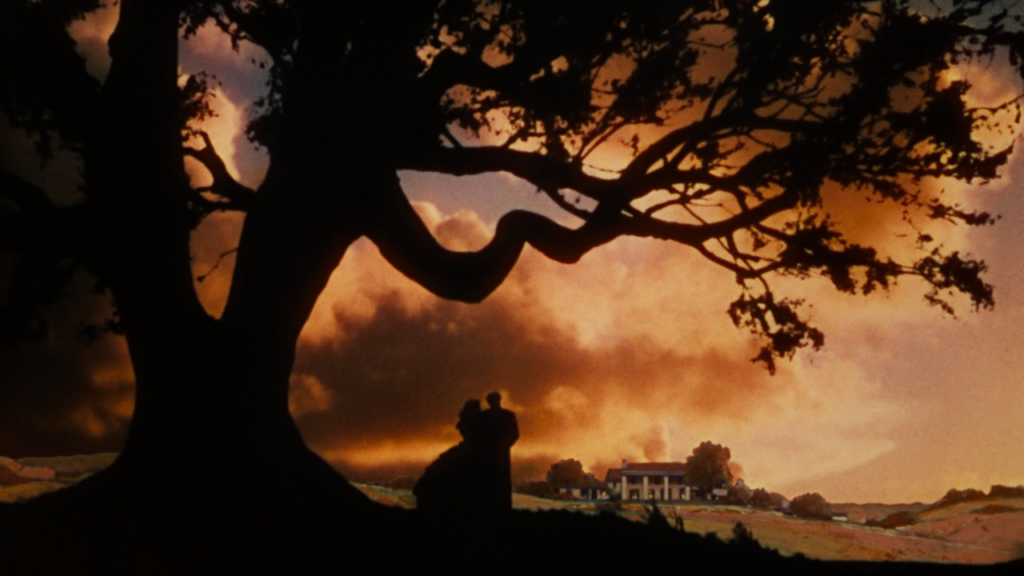
Gone With The Wind (1939)
– Paramount, which was known as the more European studio and got German directors over to make films

Shanghai Express (1932)
– Warner Brothers, which made low budget movies like gangster movies and musicals

The Public Enemy (1931)
– 20th Century Fox, famous for making westerns, musicals and dramas
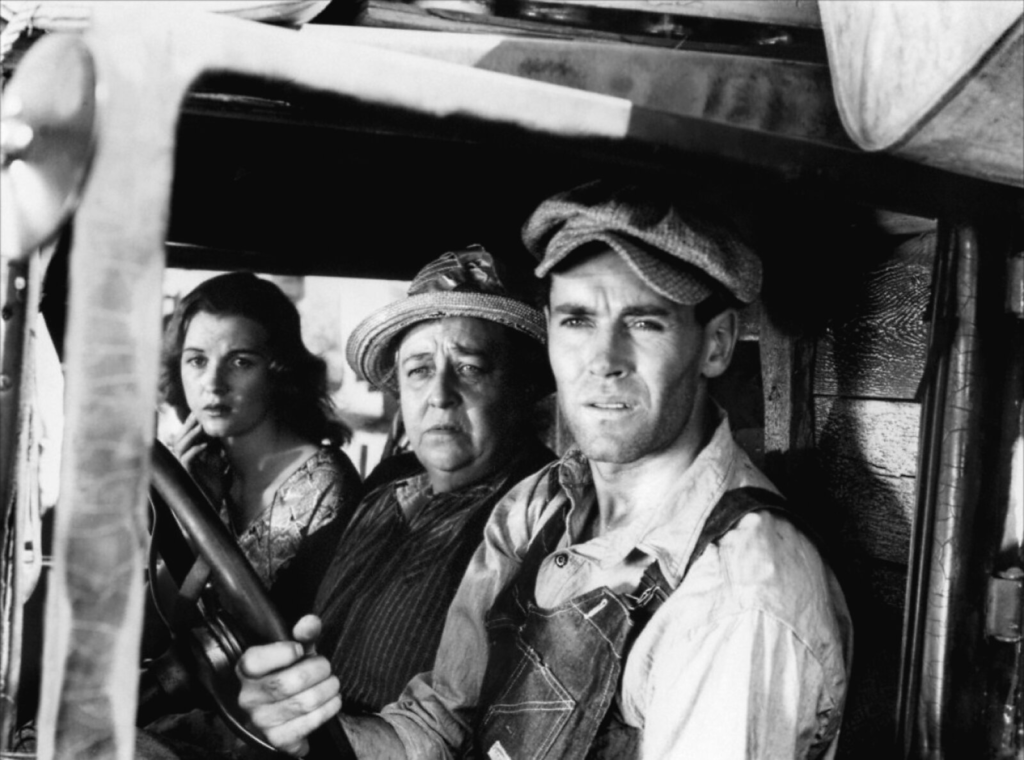
The Grapes Of Wrath (1940)
-RKO, which made a variety of films from musicals to screwball comedies to creature features and even dramas such as Citizen Kane

Citizen Kane (1941)
2. Vertical integration is the combination of two or more stages of production in a business. Block booking is a system of selling multiple films to a theatre as a unit.
3. The original studio system collapsed in 1948 at the conclusion of the United States v. Paramount court case when the 5 big studios were found of violating trust laws.
4. At this time, America went through the Great Depression. America also went through the second world war in the 1940s.
5. At the time people enjoyed movies of the westerns, musicals, screwball comedies and film noir genres. More people than ever went to visit the cinema during this time to escape the great depression, which took a large toll on the mental health of the American population.
Aesthetics is the style and tone of a film.
Realism
Realism is an attempt to make the audience believe in the world the film creates
Verisimilitude – When a film conveys a sense of truthfulness and realism, sometimes requiring suspension of disbelief

Intruder (1989, Scott Spiegel)
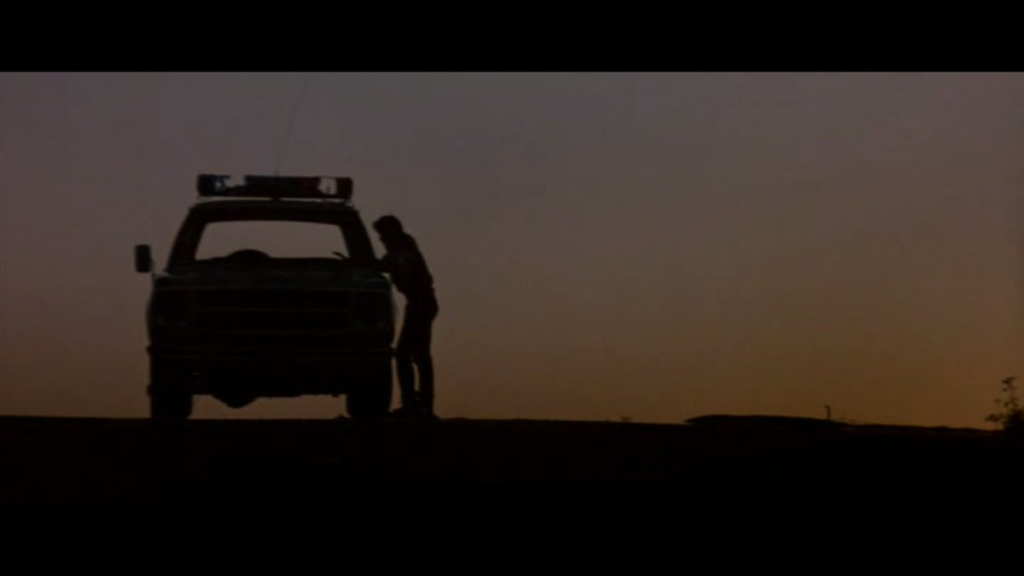
The Hitcher (1986, Robert Harmon)
Social Realism – The movie displays a social environment and its impacts on the characters in it.
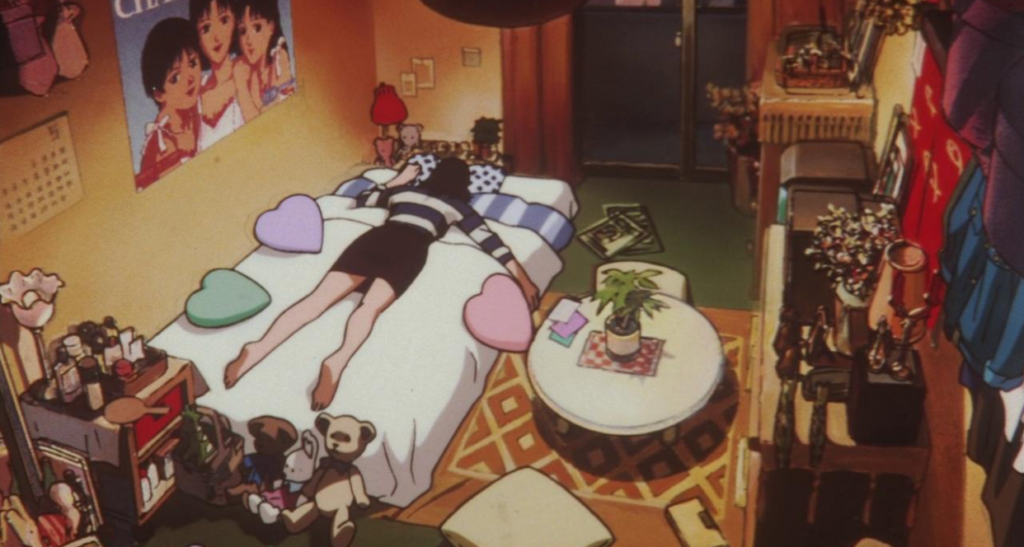
Perfect Blue (1997, Satoshi Kon) – Kon uses the film to critique the Japanese idol system and how celebrities are treated.
Magic Realism – Surreal and fantastical elements have been incorporated into an otherwise realistic setting

Carrie (1976, Brian De Palma)
Hyperreality – A film in which the reality portrayed is exaggerated, or is “too real to be real”

The Matrix Reloaded (2003,The Wachowzkis)
Visual Style
Iconography – Use of reoccurring visual symbols that convey emotion and provide symbolism

Lady Vengeance (2005, Park Chan-Wook) – the colour white is used in the movie to show purity, revenge and devotion.
Intertextual Referencing – When a film incorporates aspects of another work (another film, book, series, poetry etc)
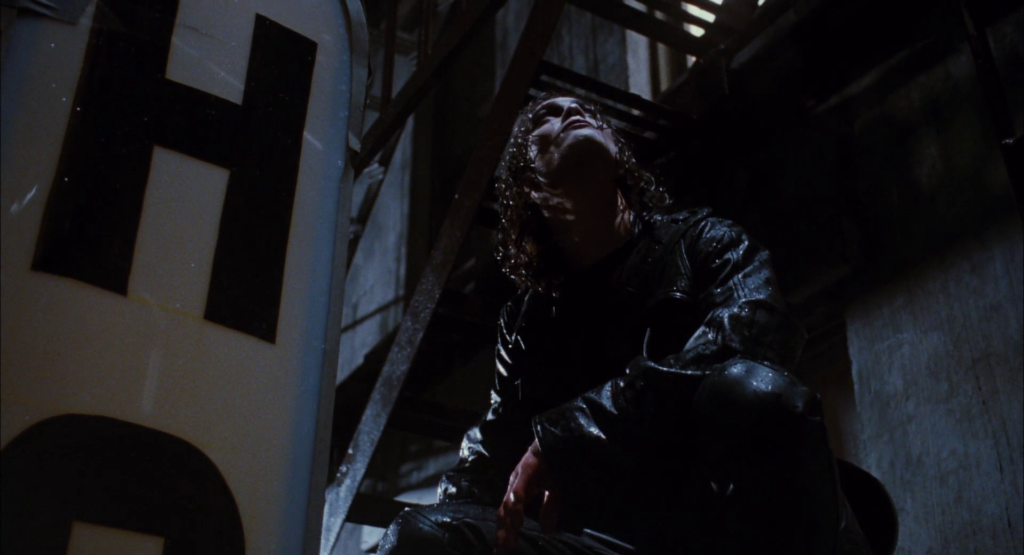
The Crow (1994, Alex Proyas) – The graphic novel the film was based on was heavily inspired by the band Joy Division and quoted song titles in the artwork frequently, and the film itself quotes classic literature like ‘Paradise Lost’ and Edgar Allen Poe’s ‘The Raven‘
Visual/Sound motifs – Recurring element in a film to help the story like announcing a character, punctuating a plot point or highlighting a theme
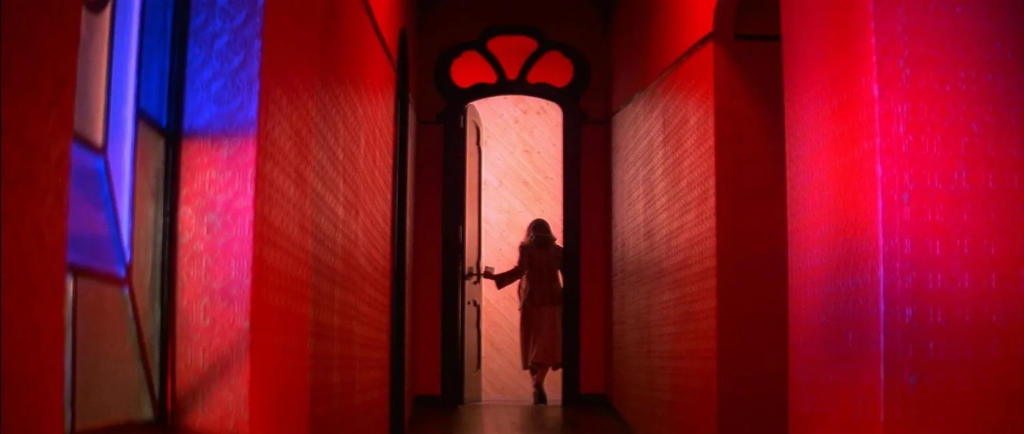
Suspiria (1977, Dario Argento) – Suspiria uses a lot of unnatural red and blue lighting, creating a dreamlike feel and being used to announce the appearance of supernatural forces or death
Colour Grading – changing the colour of footage in post production to create a constant colour scheme or to represent a theme

Manhunter (1986, Michael Mann)
Auteur trademark – a visual technique used prominently by a particular director that an audience can use to recognise as their work

Phantom Of The Paradise (1974, Brian De Palma) – De Palma uses split screen often in his works
Tone
A films tone is how it portrays its subject matter and how the audience should feel while watching the film
Pathos – Something in a film that invokes pity and compassion in the spectator
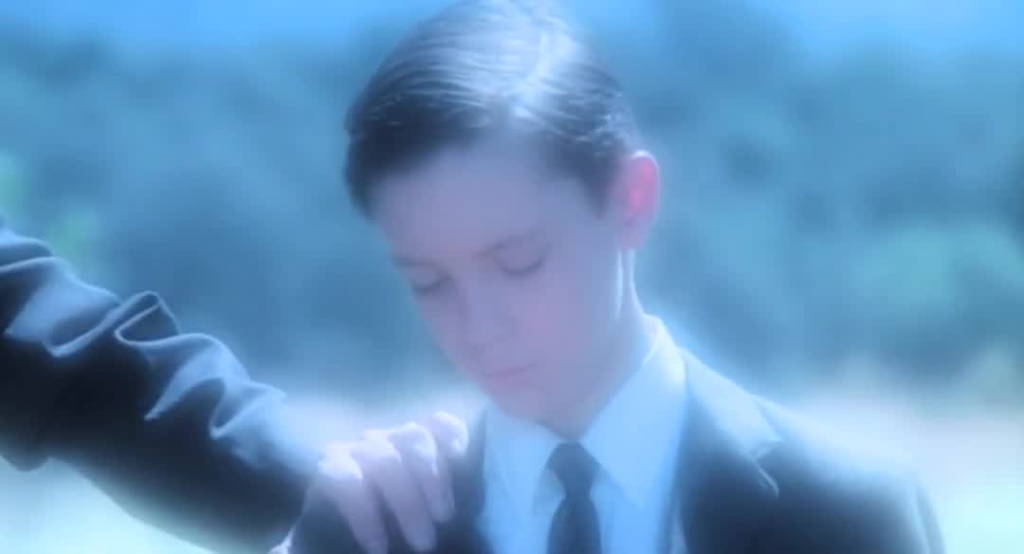
Stand By Me (1986, Rob Reiner) – Gordie dreams that his father tells him he should have died instead of his brother
Bathos – an effect of anticlimax

Se7en (1995, David Fincher) – The main antagonist of the film turns himself in
Suspense – When the director creates anticipation and anxiousness in the audience during tense scenes
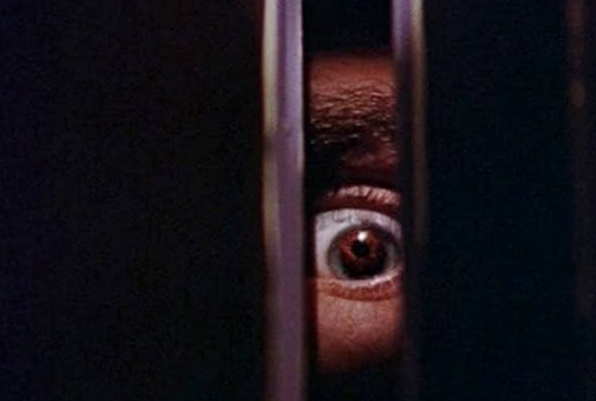
Black Christmas (1974, Bob Clark)
Comedy – aspects in a film intended to make a spectator laugh and entertain them

Scary Movie (2000, Keenen Ivory Weyans)
Dramatic Irony – When the audience knows something a character doesn’t

Woman Of The Hour (2023, Anna Kendrick) – The audience knows Rodney is a killer. Cheryl doesn’t.
Distancing Effect (V-Effekt) – When the audience is reminded that they are watching a film and are “alienated” from the world of the film

The Muppet Movie (1979, James Frawley) – Dr. Teeth reads the films script
Postmodern Humour – when a film subverts mainstream audience expectations
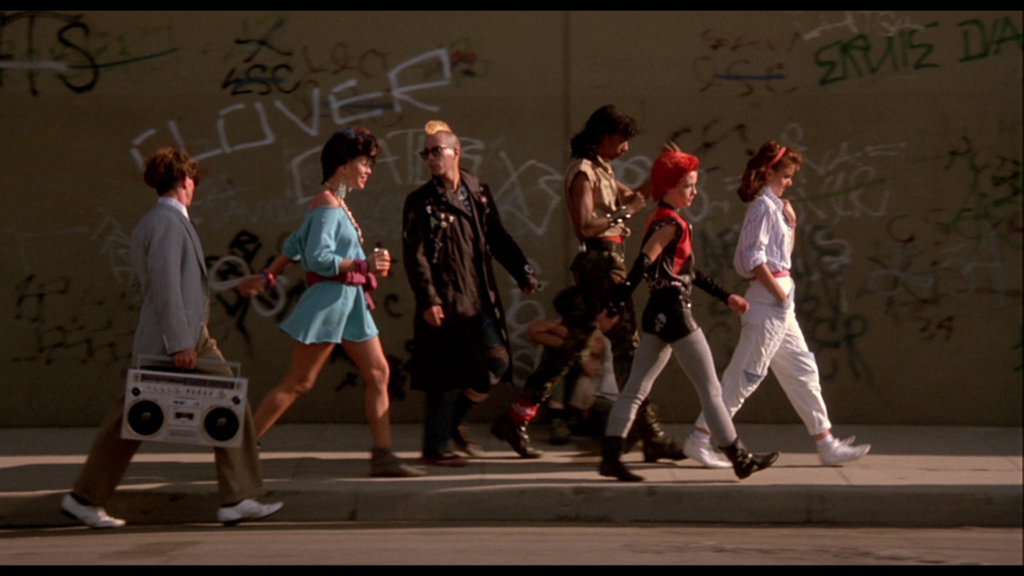
Return Of The Living Dead (1985, Dan O’Bannon) – The film subverts the standard horror movie format at the time by making the main cast a group of punks and low wage workers and giving them personalities and depth